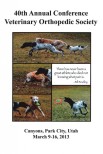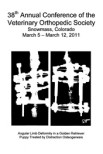CASE DESCRIPTION: An 8-month-old American Bulldog was presented for assessment of bilateral thoracic limb lameness. Computed tomographic imaging revealed large, deep osteochondritis dissecans lesions in both humeral heads.
TREATMENT AND OUTCOME: The osteochondritis dissecans lesions were debrided and the exposed subchondral defects were prepared to receive synthetic grafts. Circular implants consisting of a surface layer of polycarbonate urethane and a deep layer of lattice-type titanium were implanted into the osteochondral defects to reconstruct the articular surface topography. Follow-up clinical examination 1.5, 3 and 9 months postoperatively revealed a lack of signs of shoulder pain and resolution of thoracic limb lameness. Nine-month follow-up radiographs showed radiographic evidence of osteointegration of both implants.
CLINICAL RELEVANCE: Synthetic osteochondral implantation in the caudocentral aspect of the humeral head appeared technically feasible and effective in resolving lameness caused by humeral head osteochondritis dissecans.









